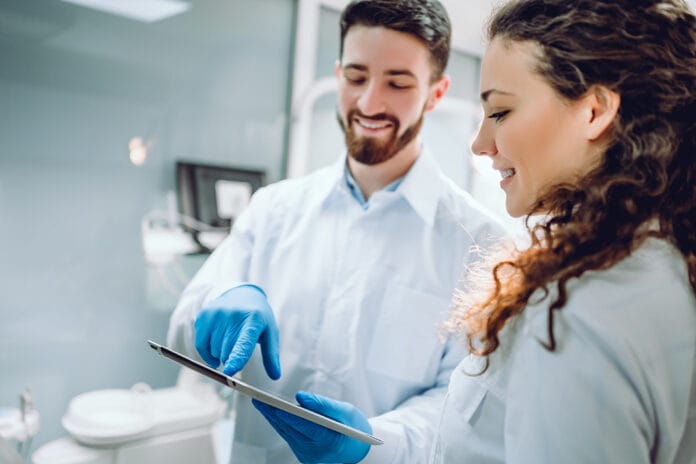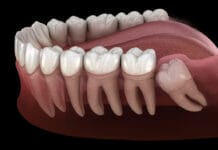Dental hygienists are essential partners in periodontal and orthodontic specialty treatments. The dental hygienist is vital in the collaborative patient care behind periodontal disease and misaligned teeth. The collaborative role that each dental team member and provider plays can positively or negatively influence patients’ perceptions of the practice, their trust in the providers, and their overall treatment acceptance.
We know that dental hygienists spend the most chair-time with patients. “Patients who reported feeling respected talked about being compliant with preventive care recommendations because they felt they were being treated as a person and not as a patient.”1 Therefore, dental hygienists play the primary role in the collaboration between a general dental practice and specialty practices.
Since periodontists are trained to treat cases of disease in the gingival tissue and supporting bone, they are dependent on strong partnerships and relationships with hygienists who possess an expertise that provides a first line of defense against the development of infection, working with the dentists to identify which patients need specialized treatment.
In some cases, referrals to the periodontist can be a touchy subject for general dentistry offices. Many general practitioners (GP) are reluctant to refer due to a common concern of never getting their patients back. Others are fearful of referring patients due to the pain and financial burdens of periodontal surgery.
As dental professionals, we must take the emotion out of the scenario and lead with our clinical mindset, which is to properly educate and recommend necessary treatment based on its effects on the oral and systemic health concerns and needs of the patient. It is important that, when you are referring to a specialist, there has been an initial treatment and referral protocol established between the GP practice and the specialty office, and hygienists need to be a part of the conversations.
Periodontist Connection
In my experience collaborating with specialty providers, our practice first scheduled a lunchtime meeting with the periodontist where we learned about his practicing philosophy. We discussed ours as well, which we found to be in alignment with each other. The periodontist was centered on patient care and had a positive and empathetic chairside manner. The doctor is a proponent of patient education to reinforce why particular treatment is needed and keeps abreast of new technology and treatment to provide efficient care conservatively. We agreed on the following standard of care protocol:
- The GP hygienist would complete all the initial data gathering, including radiographs, intraoral camera images, complete periodontal charting, and refer any patients with >7mm probing depths, class III mobility, class II furcation involvement, generalized moderate-advanced radiographic bone loss, and gingival graft candidate patients to the periodontist for evaluation and treatment.
- If a patient has been receiving regular periodontal maintenance therapy, including locally administered antibiotic regimens with no improvement to their gingival health, the patient is to be referred to the periodontist for an evaluation.
- Once periodontal specialty treatment was completed and stabilized, the patient would return to the GP hygienist for three-month periodontal maintenance therapy, periodic exams, and radiographs as needed while still being seen by the periodontist on the alternating three-month recare cycle for the first year. If, after the first year, the periodontist deems the patient is stable, then the patient will solely have the periodontal maintenance therapy completed by the GP hygienist and will have an annual gingival evaluation with the periodontist.
Orthodontist Connection
The best strategy dental hygienists can employ to incorporate orthodontic considerations into the practice is to connect and refer to local orthodontic practices. The dental hygienist has unique opportunities to impact this specialized area of dentistry, ranging from education to assessment to supportive therapies during orthodontic treatment.
The American Academy of Periodontology has specified occlusal examination as part of the periodontal assessment. The 2011 Comprehensive Periodontal Therapy statement includes the following: “An occlusal examination that includes, but may not be limited to, determining the degree of mobility of teeth and dental implants, occlusal patterns and discrepancy, and determination of fremitus. Occlusal therapy that may include tooth movement, occlusal adjustment, splinting, periodontally accelerated osteogenic orthodontics, or biteguard therapy as a means to establish and maintain occlusal health;” and “Procedures to facilitate orthodontic treatment including tooth exposure, frenulectomy, fiberotomy, temporary anchorage devices, and gingival augmentation.”2
Regarding the collaboration with the orthodontic specialty provider, we too had a lunch meeting and discussed our practicing philosophies and developed the following action plan:
- All pediatric patients will have a panoramic radiograph taken and be referred to an orthodontist for initial evaluation beginning at the age of seven years.
- If a pediatric patient under the age of seven years presents to the office with a Class III occlusion or another immediate orthognathic concern, a referral to the orthodontist is needed.
- Adult patients with malalignment will be referred to the orthodontist for evaluation and treatment needed outside the GP scope of providing clear aligner therapy.
- All patients under orthodontic treatment will be recommended to be seen on a four-month recare cycle by the GP hygienist and receive an in-office fluoride treatment.
- At-home standard of care product expectations are for the patient to use a power toothbrush, water flosser, and fluoride to maintain optimal oral health.
There were no formal contracts signed between the GP and specialty practices for referrals. The agreed-upon communication was that each provider would provide a standard-of-care written report on date-of-service treatment, additional recommendations, and next steps. This standard of care report was an important part of the care process and was saved into the patient’s chart for future reference, treatment needs, and any communication required for a medical physician if applicable.
These collaborations and specialty partnerships resulted in an improved patient care management process, improved patient health, improved patient satisfaction ratings, an increase in patient referrals between both the GP and specialty practices, more effective schedules, and improved patient-provider trusting relationships.
Dental hygienists are an organized and structured group. Establishing a protocol and standard of care plan of action will enhance treatment opportunities and provide clinicians with the satisfaction of delivering the quality of care that our patients deserve.
Before you leave, check out the Today’s RDH self-study CE courses. All courses are peer-reviewed and non-sponsored to focus solely on pure education. Click here now.
Listen to the Today’s RDH Dental Hygiene Podcast Below:
References
- Dalonges, D.A., Fried, J.L. Creating Immediacy Using Verbal and Nonverbal Methods. J Dent Hyg. 2016; 90(4): 221-225.
- The American Academy of Periodontology Task Force. Comprehensive Periodontal Therapy: A Statement by the American Academy of Periodontology. Journal of Periodontology. 2011; 82(7): 943-949. Retrieved from https://doi.org/10.1902/jop.2011.117001












